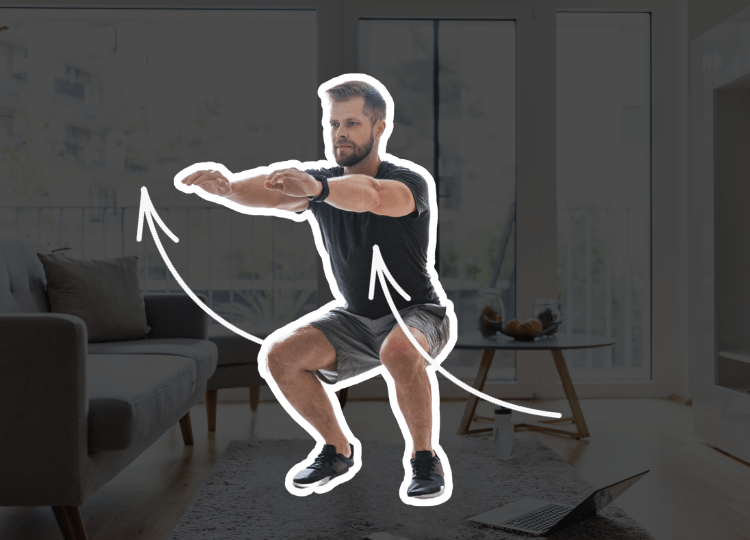If you’re looking to upgrade your squat routine, the Hindu squat (also sometimes referred to as the “Indian squat”), is a simple yet effective way to improve strength, muscular endurance, and balance… as well as helping to burn additional calories.
Originating as a training technique for Indian wrestlers hundreds of years ago, this variation of the traditional air squat has developed a loyal following of athletes, as well as podcast host Joe Rogan (who has frequently praised this style of squat).
Whether you’re a pro Indian wrestler, or simply looking for ways to build up better functional movement, we outline everthing you need to know about the Hindu squat, including how to perform them safely, the benefits, muscles worked and ultimately who should be doing them.
What Are Hindu Squats?
The Hindu squat involves swinging your arms and lifting your heels off the ground as you get into the squat position.
This requires better balance and coordination than the traditional squat, and also lends itself well for cardio workouts, such as HIIT routines, whereby you are aiming for high volumes of reps.
The movement is more complex than traditional squats and requires better coordination of your limbs during the exercise, as well as attention to your breathing.
When executed properly, it’s a style of squat that supports high intensity workouts and those on the hunt for functional movements that can aid everyday situations.
The Hindu squat will help test and develop:
- Strength
- Balance
- Breathing
- Coordination
- Shoulder mobility
What’s the Difference Between a Hindu Squat Vs a Regular Squat?
In terms of biomechanics, what look like subtle difference between a regular squat and a Hindu squat, can actually have a notable influence on how our muscles are engaged and activated.
Firstly, as the arms are swung backwards behind your body as you are in the squat, this replicates how most of us who prepare ourselves before a standing jump. We would tend to naturally swing our arms to aid the movement. Straight away, we can see how the Hindu squat reflects these sorts of athletic movements really well, and can assist those looking for workouts to support sports and physical activities.

Similarly, for lots of people who squat down during daily activities, they will tend to naturally lift their heel off the ground. When they stand up out of this position, it’s more than likely the heel will stay raised up off the floor… which means this sort of squatting movement seen in all sorts of daily activities, actually engages the muscles more similarly to a Hindu squat than a regular air squat.
(Check out our guide on how to do the Asian squat to understand this difference in squatting styles and why some people lift their heel off the ground when they squat down).
The ability to maintain adequate balance and stability during the concentric phase of the movement, also means Hindu squats can help support healthy ageing and helping to incorporate vital fitness components such as balance into common movements.
The lifted heel will also activate the quads more than a traditional squat, which is ideal if you’re looking for exercises that specifically target the quad.
The movement of the knee, heel and arms during the exercise, mean that Hindu squats don’t carry over to weighted squats (such as with a barbell or dumbbells), as well as a traditional bodyweight squat does. If you’re looking to progress to add weight to your squat and leverage training techniques like progressive overload to build muscle, you’re probably better off sticking with a traditional squat.
Nevertheless, the benefits of activating the lower body, improving balance and delivering a great burst of cardio, mean that the Hindu squat is still a great exercise to consider during your workouts… you just want to use it in the right way, as we’ll highlight throughout this article.
How To Do Hindu Squats
Check out the video below that illustrates how to do the perfect Hindu squat.
- Stand with your feet shoulder width apart, knees slightly bent and back straight.
- Extend your arms out in front of you, so they are parallel to the floor.
- As you inhale, lower yourself into a squat. As you lower yourself down, lift your heels off the floor and swing your arms backwards, behind your body.
- Keep your core, quads, glutes, hamstrings and calves activated to stablize your body.
- Exhale and swing your arms forward so they brush the floor (or as close as you can get), staying on the balls of your feet, before pushing down to lift yourself out of the squat. As you approach a standing position, lower your heels back to the floor.
- Finish the movement with your arms straight in front of you parallel to the floor.
- Repeat for repetitions.
Coach’s Tip – Although this movement can be done at quite a quick pace, it should always be controlled. If you find you’re falling onto your heels during the eccentric phase of the squat, it means you’re potentially going too quick. You’ll also notice your calves are activated a lot more than a regular squat, which may highlight if you’ve got weak calves that are struggling to keep your heels raised for the duration of a high repetition workout.
Posture is also really important, so keep looking forward and avoid the temptation to look down, as this will change your spinal alignment during the movement. Also, we would tend to recommend that you squeeze your shoulder blades together for the whole duration of the movement, helping to avoid rounded shoulders and ensure that back stays as straight as possible.
What Muscles Do Hindu Squats Target?
Hindu squats primarily target the same muscles as with a regular squat, namely the quads, hamstrings, and calves.
- Quads
- Hamstrings
- Calves
- Core
- Shoulders
Due to the raised heel, Hindu squats will activate the calves more than regular squats during the movement. The calves have to help power your body up out of the squat but also provide that extra strength to keep lifting your heels off the floor during each repetition too.
Similarly, the raised heel will also engage the quads more. This is similar to how a slant board can be used to activate the quads more during a squat.
The Hindu squats will also engage the core more than regular squats due to the extra stability needed during the exercise.
Your shoulder mobility will also be tested.

Hindu Squat Benefits
Hindu squats offer a variety of benefits and will help improve your:
- Functional fitness
- Muscular strength and endurance
- Ankle flexibility
- Balance and stability
- Knee durability
- Cardiovascular health
- Agility
- Jumping
- Quad strength
- Athletic performance for sports.
Are Hindu Squats OK for Bad Knees?
Hindu squats offer a range of benefits, but they do put pressure and stress on the knee joints.
Although the movement isn’t necessarily bad for your knees, if you already struggle with knee pain or discomfort, it’s best to avoid Hindu squats until you feel your knees can handle the extra weight they would need to support.
You could opt to use a knee sleeve or support, but we would tend to just avoid Hindu squats if you have any doubts… especially as there are so many other squat variations (e.g. lateral side squats, plié squats, frog squats, to name just a few). Similarly, there are other ways to strengthen muscles like the quads and hamstrings without squatting altogther (such as Good Mornings).
Activities like swimming (if you’re over 50, check out our guide on swimming in your 50’s) are much lower impact on joints and potentially a better alternative for those dealing with long-term injuries (a Physical Therapist or doctor will be better placed to offer personal recommendations).
Nevertheless, assuming they are performed correctly they can help develop stronger knees that are more adapt to pressure and strain (helping reduce the risk of injury due to pressure or strain).
So, although it can cause discomfort for your knees, in the long-term, it can help mean your knees are better prepared for whatever is thrown their way.
Weighted Hindu Squats
Once you’ve given Hindu squats a go, you may want to add some weight to make them more challenging. Due to the balance and control needed for Hindu squats, any weight added should start off really low and slowly increased.
It’s also not a movement that is suited to heavy weights… it’s like trying to push a triangle shape into a circular hole, it’s just not a good fit.
If you want to add weight, using a weighted vest or wearing wrist weights would be your best bet.
You could try to hold light dumbbells as this would allow you to still swing your arms. This will be challenging so go as light as possible to begin with.
Bottom Line
Hindu squats can be a fantastic exercise to help support functional fitness and movement.
They can help activate the quads more, improve your balance, and ultimately deliver an effective cardio workout that doesn’t need any equipment.
It is best performed as a slow and controlled movement. It’s always worth consulting a Physical Therapist or doctor to ensure Hindu squats are right for you and your current state of health.
Related articles:
